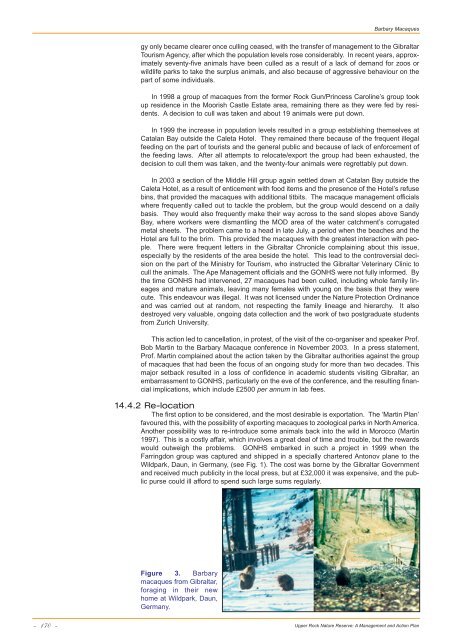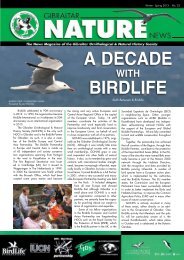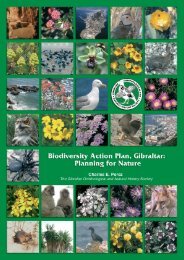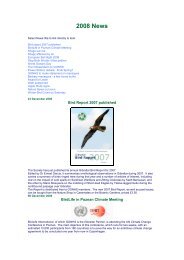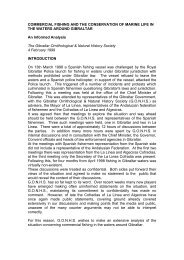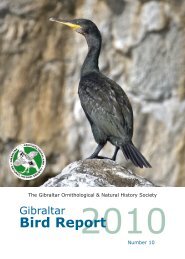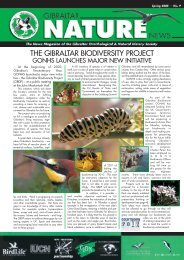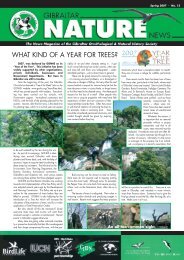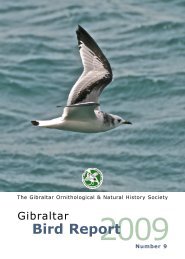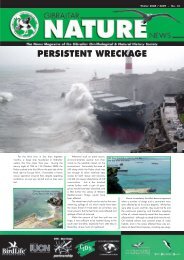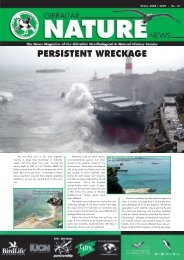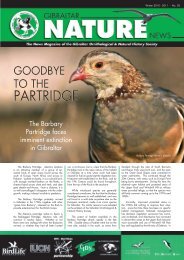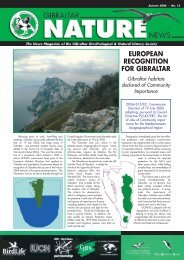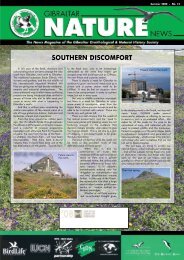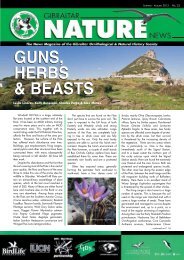Upper Rock Nature Reserve: A Management and Action Plan
Upper Rock Nature Reserve: A Management and Action Plan
Upper Rock Nature Reserve: A Management and Action Plan
You also want an ePaper? Increase the reach of your titles
YUMPU automatically turns print PDFs into web optimized ePapers that Google loves.
- 170 -<br />
Barbary Macaques<br />
gy only became clearer once culling ceased, with the transfer of management to the Gibraltar<br />
Tourism Agency, after which the population levels rose considerably. In recent years, approximately<br />
seventy-five animals have been culled as a result of a lack of dem<strong>and</strong> for zoos or<br />
wildlife parks to take the surplus animals, <strong>and</strong> also because of aggressive behaviour on the<br />
part of some individuals.<br />
In 1998 a group of macaques from the former <strong>Rock</strong> Gun/Princess Caroline’s group took<br />
up residence in the Moorish Castle Estate area, remaining there as they were fed by residents.<br />
A decision to cull was taken <strong>and</strong> about 19 animals were put down.<br />
In 1999 the increase in population levels resulted in a group establishing themselves at<br />
Catalan Bay outside the Caleta Hotel. They remained there because of the frequent illegal<br />
feeding on the part of tourists <strong>and</strong> the general public <strong>and</strong> because of lack of enforcement of<br />
the feeding laws. After all attempts to relocate/export the group had been exhausted, the<br />
decision to cull them was taken, <strong>and</strong> the twenty-four animals were regrettably put down.<br />
In 2003 a section of the Middle Hill group again settled down at Catalan Bay outside the<br />
Caleta Hotel, as a result of enticement with food items <strong>and</strong> the presence of the Hotel’s refuse<br />
bins, that provided the macaques with additional titbits. The macaque management officials<br />
where frequently called out to tackle the problem, but the group would descend on a daily<br />
basis. They would also frequently make their way across to the s<strong>and</strong> slopes above S<strong>and</strong>y<br />
Bay, where workers were dismantling the MOD area of the water catchment’s corrugated<br />
metal sheets. The problem came to a head in late July, a period when the beaches <strong>and</strong> the<br />
Hotel are full to the brim. This provided the macaques with the greatest interaction with people.<br />
There were frequent letters in the Gibraltar Chronicle complaining about this issue,<br />
especially by the residents of the area beside the hotel. This lead to the controversial decision<br />
on the part of the Ministry for Tourism, who instructed the Gibraltar Veterinary Clinic to<br />
cull the animals. The Ape <strong>Management</strong> officials <strong>and</strong> the GONHS were not fully informed. By<br />
the time GONHS had intervened, 27 macaques had been culled, including whole family lineages<br />
<strong>and</strong> mature animals, leaving many females with young on the basis that they were<br />
cute. This endeavour was illegal. It was not licensed under the <strong>Nature</strong> Protection Ordinance<br />
<strong>and</strong> was carried out at r<strong>and</strong>om, not respecting the family lineage <strong>and</strong> hierarchy. It also<br />
destroyed very valuable, ongoing data collection <strong>and</strong> the work of two postgraduate students<br />
from Zurich University.<br />
This action led to cancellation, in protest, of the visit of the co-organiser <strong>and</strong> speaker Prof.<br />
Bob Martin to the Barbary Macaque conference in November 2003. In a press statement,<br />
Prof. Martin complained about the action taken by the Gibraltar authorities against the group<br />
of macaques that had been the focus of an ongoing study for more than two decades. This<br />
major setback resulted in a loss of confidence in academic students visiting Gibraltar, an<br />
embarrassment to GONHS, particularly on the eve of the conference, <strong>and</strong> the resulting financial<br />
implications, which include £2500 per annum in lab fees.<br />
14.4.2 Re-location<br />
The first option to be considered, <strong>and</strong> the most desirable is exportation. The ‘Martin <strong>Plan</strong>’<br />
favoured this, with the possibility of exporting macaques to zoological parks in North America.<br />
Another possibility was to re-introduce some animals back into the wild in Morocco (Martin<br />
1997). This is a costly affair, which involves a great deal of time <strong>and</strong> trouble, but the rewards<br />
would outweigh the problems. GONHS embarked in such a project in 1999 when the<br />
Farringdon group was captured <strong>and</strong> shipped in a specially chartered Antonov plane to the<br />
Wildpark, Daun, in Germany, (see Fig. 1). The cost was borne by the Gibraltar Government<br />
<strong>and</strong> received much publicity in the local press, but at £32,000 it was expensive, <strong>and</strong> the public<br />
purse could ill afford to spend such large sums regularly.<br />
Figure 3. Barbary<br />
macaques from Gibraltar,<br />
foraging in their new<br />
home at Wildpark, Daun,<br />
Germany.<br />
<strong>Upper</strong> <strong>Rock</strong> <strong>Nature</strong> <strong>Reserve</strong>: A <strong>Management</strong> <strong>and</strong> <strong>Action</strong> <strong>Plan</strong>


